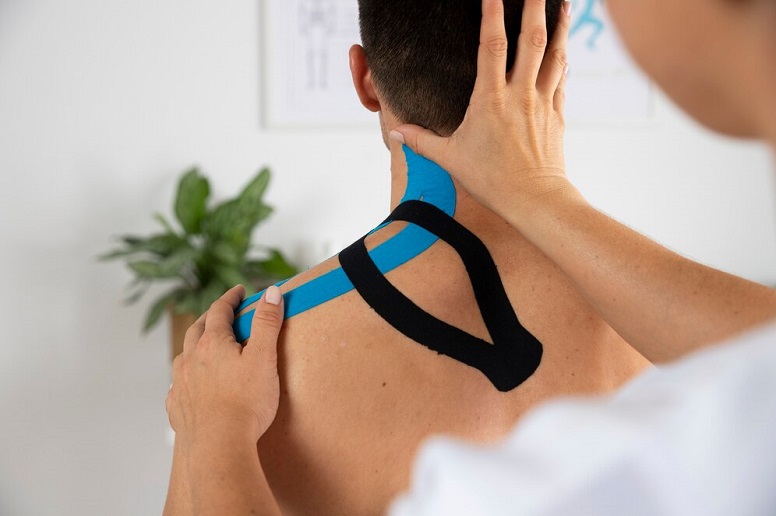In the world of holistic rehabilitation and therapeutic interventions, Kinesio Taping Therapy has emerged as a game-changer. This innovative approach, characterized by the application of specialized adhesive tapes on the body, has gained widespread recognition for its ability to alleviate pain, address weaknesses, and promote overall well-being. In this comprehensive blog, we’ll delve into the intricacies of Kinesio Taping Therapy, exploring its history, principles, application techniques, and the remarkable impact it has on managing pain and weakness.
Understanding Kinesio Taping Therapy: Kinesio Taping Therapy is rooted in the idea that the body possesses an innate ability to heal itself when provided with the right support. Developed by Dr. Kenzo Kase, a Japanese chiropractor, in the 1970s, this therapeutic technique involves the application of elastic tapes onto specific areas of the body. Unlike traditional athletic tapes, Kinesio Tape is designed to mimic the elasticity of human skin, allowing for a wide range of motion and flexibility.
THE PRINCIPLES BEHIND KINESIO TAPING:
Facilitation of Healing Processes: Kinesio Taping Therapy is grounded in the belief that the application of the specialized tape can influence and enhance the body’s natural healing processes. By providing support to muscles and joints, it aims to facilitate optimal blood circulation, lymphatic drainage, and reduce inflammation.
Muscle and Joint Support: The unique elastic properties of Kinesio Tape make it an effective tool for providing support to muscles and joints without restricting movement. This support is crucial for individuals dealing with pain and weakness, as it helps in maintaining proper alignment and function.
Neurological Feedback: The application of Kinesio Tape is thought to stimulate neurological feedback, influencing the perception of pain and encouraging better movement patterns. This neurological aspect is key to addressing weakness and promoting functional improvements.
Application Techniques: Kinesio Taping Therapy involves meticulous application techniques to ensure optimal results. Here are some key considerations:
Preparation of the Skin: Before applying the tape, it’s essential to clean and prepare the skin to ensure proper adhesion. The use of hypoallergenic and latex-free tape minimizes the risk of skin irritation.
Tape Cutting and Shape: The tape is cut into specific shapes and lengths, depending on the targeted area and desired therapeutic effect. Y-strips, I-strips, and fan cuts are common shapes used in different applications.
Tension and Stretch: The amount of tension and stretch applied during taping plays a crucial role in achieving therapeutic goals. Certified practitioners are trained to apply the tape with the right tension to provide support without causing discomfort.
KINESIO TAPING FOR PAIN MANAGEMENT:
Musculoskeletal Pain: Kinesio Taping has shown promising results in managing musculoskeletal pain, such as back pain, knee pain, and shoulder pain. The tape’s support helps reduce strain on affected muscles and joints, promoting a more comfortable and pain-free experience.
Sports Injuries: Athletes often turn to Kinesio Taping for both prevention and rehabilitation of sports-related injuries. The tape aids in stabilizing joints, improving muscle function, and accelerating the recovery process.
Chronic Pain Conditions: Individuals dealing with chronic pain conditions, such as fibromyalgia or arthritis, may find relief through Kinesio Taping. The tape’s application can help modulate pain perception and improve overall comfort.
KINESIO TAPING FOR ADDRESSING WEAKNESS:
Postural Weakness: Poor posture can contribute to weakness in various muscle groups. Kinesio Taping is utilized to support and encourage proper alignment, helping individuals overcome postural weaknesses.
Muscle Imbalances: When there is an imbalance between opposing muscle groups, weakness can ensue. Kinesio Taping aids in addressing these imbalances by providing targeted support to weaker muscles, promoting improved symmetry and strength.
Rehabilitation after Surgery: Individuals recovering from surgical procedures often experience muscle weakness. Kinesio Taping is incorporated into rehabilitation programs to provide support, enhance circulation, and expedite the recovery of weakened muscles.
Conclusion: In the realm of holistic health and rehabilitation, Kinesio Taping Therapy stands as a versatile and effective modality for managing pain and addressing weaknesses. Its application extends across diverse populations, from athletes and individuals with chronic conditions to those recovering from surgery. As we continue to unravel the complexities of the human body and explore innovative therapeutic approaches, Kinesio Taping remains a beacon of hope for those seeking natural and non-invasive solutions.
Embark on your journey towards pain relief and strength restoration by considering Kinesio Taping Therapy. Consult with certified practitioners and discover how this revolutionary approach can positively impact your well-being. Call us at 905-670-9188 & take the first step towards a stronger tomorrow – explore the world of Kinesio Taping at Derry Village Physiotherapy today!

